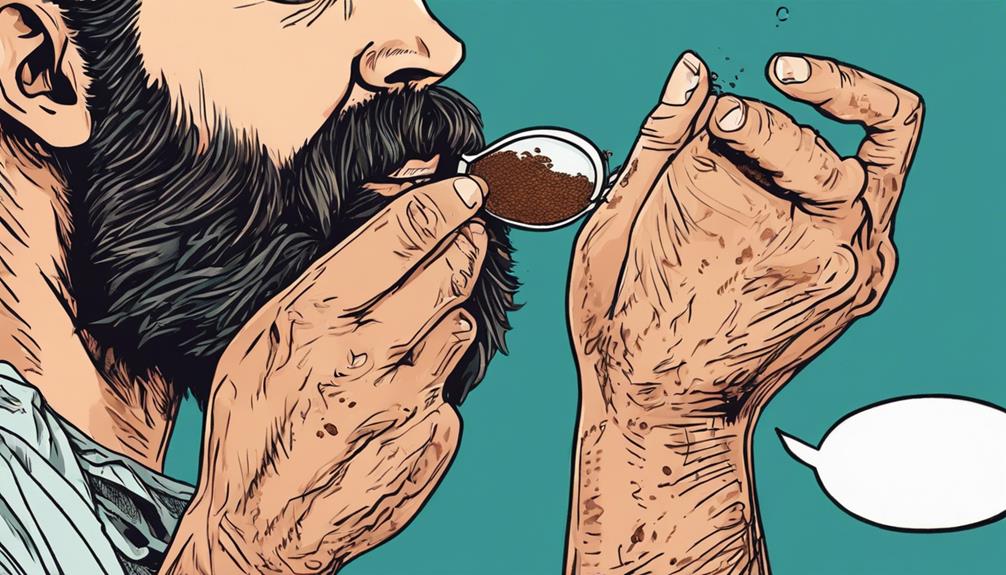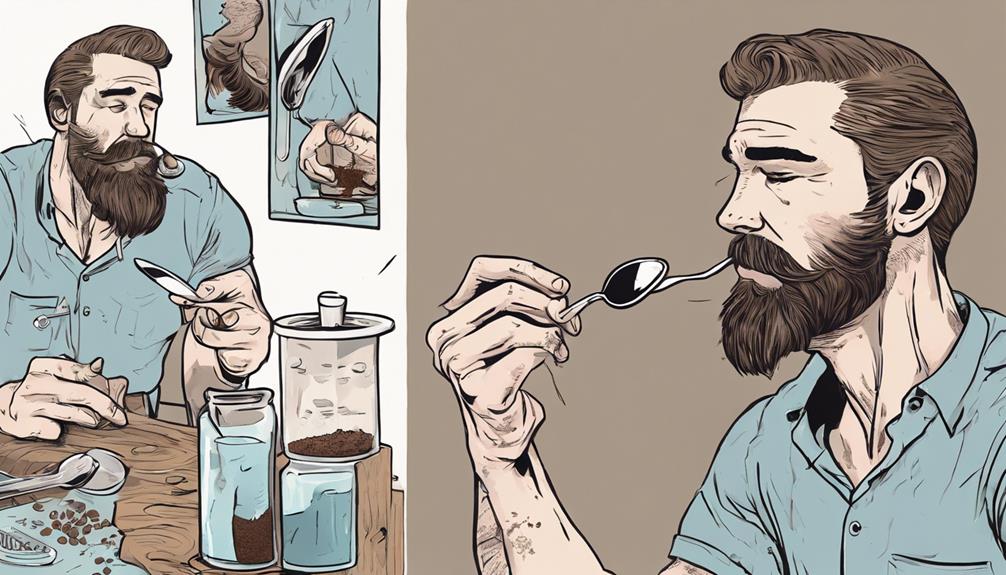Revitalize your beard with coffee to encourage growth and add shine! Brew a strong cup of coffee, allow it to cool. Gently massage the coffee into your beard, then rinse. The caffeine in coffee stimulates hair follicles for healthier growth and a smooth finish. The antioxidants in coffee protect against damage, promoting a fuller beard. Remember, moderation is key; don’t go overboard for optimal results. Consider using caffeine-infused products as part of your maintenance routine to rejuvenate your beard. Coffee isn’t just for mornings – it may be the key to a healthier, more vibrant beard. For those wanting to elevate their coffee hair treatment, try using a coffee-infused hair mask or conditioner to further nourish and strengthen your beard. Introducing a regular coffee hair treatment into your grooming routine can also minimize breakage and enhance overall hair health. With the benefits of caffeine and antioxidants, it’s no surprise that coffee is a popular choice for men seeking to improve their beards.
Key Takeaways
- Brew strong coffee for a rinse.
- Apply coffee to damp beard.
- Massage into skin and hair.
- Leave on for 20 minutes.
- Rinse with warm water for growth and shine.
Antioxidant Benefits of Caffeine
Regularly applying coffee on your beard can provide valuable antioxidant benefits due to the caffeine content. The antioxidants in caffeine play a pivotal role in protecting your facial hair from free radicals, ultimately contributing to healthier beard growth.
These antioxidants not only safeguard your beard but also stimulate the production of healthy cells, leading to improved skin health and overall well-being. To maximize the antioxidant benefits of caffeine, opt for dark coffee bean products like espresso or French roast.
By incorporating these types of coffee into your beard care routine, you can kickstart your day with a boost of antioxidants that promote a luscious and vibrant beard. Additionally, using caffeine-infused products can further enhance the health of your hair follicles, ensuring that your beard remains strong and healthy.
Prioritizing antioxidant-rich coffee for your beard care can lead to significant improvements in both the look and feel of your facial hair.
Hair Growth Acceleration With Caffeine

Applying caffeine-infused products on your beard can greatly accelerate the hair growth cycle. Scientific studies have revealed that caffeine can boost beard growth by up to 40%. Dr. Tobias Fischer's research further supports this, showing that caffeine not only speeds up the rate but also enhances the length of beard growth.
By using products containing caffeine, you can promote healthier hair follicles, leading to faster and longer beard growth.
To maximize the benefits, consider massaging caffeine-based products into your beard regularly. This process can improve blood circulation to the hair follicles, stimulating growth. Over time, consistent use of these products can result in a fuller and healthier beard.
Healthier Hair Follicles With Caffeine

You can achieve healthier hair follicles by incorporating caffeine into your grooming routine.
The stimulating properties of caffeine help promote better blood flow to your hair follicles, encouraging stronger and more resilient hair growth.
Benefits of Caffeine
Stimulating hair follicles with caffeine can lead to healthier growth and improved hair quality. Caffeine, known for its energizing properties, when incorporated into hair products, can work wonders for your beard.
By massaging caffeine-infused products into your beard, you aren't only improving blood circulation to the follicles but also providing necessary nutrients that strengthen the hair strands and reduce breakage. The result is a beard that not only looks healthier but also feels smoother and silkier to the touch.
Regular use of caffeine products can have a cumulative effect, promoting overall healthier-looking hair that radiates energy and strength. So, if you're aiming to enhance your beard's growth and shine, incorporating caffeine into your grooming routine could be the boost your beard needs for that extra edge in maintaining its health and luster.
Stimulating Hair Follicles
Enhance the health of your beard's hair follicles by incorporating caffeine into your grooming routine. Caffeine has the remarkable ability to stimulate hair follicles, leading to healthier and stronger beard growth.
Here's how caffeine can benefit your hair follicles:
- Promotes Blood Circulation: Massaging caffeine-infused products into your beard can improve blood flow to the hair follicles, enhancing their health and promoting better growth.
- Strengthens Hair: Nutrients from caffeine work to strengthen both the hair follicles and shafts, reducing breakage and improving the overall quality of your beard.
- Enhances Manageability: Regular use of caffeine products can result in smoother and silkier hair, making your beard easier to manage and style.
- Revitalizes Follicles: Caffeine-infused products nourish and revitalize the hair follicles, encouraging healthier and more robust beard growth over time.
Caffeine Usage Moderation Tips

To maintain a healthy balance while utilizing caffeine for beard growth, it's important to prioritize moderation. Excessive caffeine intake can lead to adverse effects such as anxiety or heart palpitations, so it's crucial to follow recommended doses.
When applying caffeine topically on your beard, be careful of not overdoing it, as an overdose could hinder growth rather than promote it. Proper application methods play a significant role in ensuring the effectiveness of caffeine-infused hair products. Always follow the directions provided with such products to achieve best results and avoid any potential drawbacks.
Similarly, when taking supplements containing caffeine to boost beard growth, sticking to the recommended doses is crucial to prevent unwanted side effects. By moderating your caffeine usage and adhering to suggested guidelines, you can harness its benefits for your beard without experiencing any negative consequences.
Caffeine in Beard Maintenance Routine

You can enhance your beard maintenance routine by incorporating caffeine-infused products, such as oils and balms. Massaging these products into your beard can stimulate hair follicles, promoting healthier growth and overall hair health.
Opting for natural coffee-infused products can nourish your beard, leaving it smoother, softer, and more manageable.
Caffeine for Beard Health
Consider incorporating caffeine-infused beard products like oils or balms into your beard maintenance routine to promote healthier hair follicles. When using caffeine for beard health, here's what you should know:
- Improved Blood Circulation:
Massaging caffeine products into your beard can enhance blood flow to the hair follicles, aiding in growth and strength.
- Stronger Hair Follicles and Shafts:
Caffeine has the potential to fortify hair follicles and shafts, reducing breakage and enhancing the overall look of your beard.
- Gentle Cleansing and Stimulation:
Opt for a natural beard wash infused with caffeine to cleanse gently, stimulate hair growth, and prevent dryness and itching.
- Silkier, Healthier Beard:
Regular use of caffeine-infused products can result in a smoother, silkier beard with improved health and growth.
Benefits of Coffee Application
Incorporating coffee into your beard maintenance routine can provide various benefits for promoting healthier and more manageable facial hair.
The caffeine in coffee stimulates blood flow, enhancing hair growth and contributing to a fuller beard.
Additionally, coffee-infused products can moisturize and condition the beard, making it smoother and easier to style.
The antioxidants present in coffee help combat free radicals, preventing premature aging of the beard hair.
Regular use of coffee on your beard can improve blood circulation to the skin, ensuring essential nutrients reach the hair follicles for best growth.
Additionally, coffee's ability to reduce frizziness in the beard results in a more polished and controlled appearance.
Coffee's Impact on Beard Moisture

Enhancing beard moisture, applying coffee can prevent dryness and itchiness, providing hydration and promoting a healthy appearance. By incorporating coffee into your beard care routine, you can enjoy the following benefits:
- Improved Hydration: Coffee-infused products help retain moisture in your beard, keeping it soft and manageable.
- Natural Shine: Coffee promotes moisture retention, giving your beard a healthy, shiny look.
- Frizz Control: Combat frizziness by using coffee on your beard, enhancing overall moisture levels.
- Nourishment: Coffee application nourishes your beard, improving its health by keeping it well-moisturized.
Incorporating coffee into your grooming regimen not only helps in maintaining beard health but also adds a touch of natural shine and hydration. Say goodbye to dry, itchy beard days and welcome a well-moisturized, healthy-looking beard with the power of coffee.
Coffee for Beard Color Enhancement

To enhance your beard's color naturally, consider using coffee as a safe and effective dye option. Coffee grounds can be utilized to cover up gray hairs in black or brown beards, providing a darker and more vibrant appearance.
By preparing a simple brewed coffee rinse and applying it to your beard, you can achieve a natural color enhancement while adding volume and shine to your facial hair.
The process of using coffee as a beard dye is straightforward and can be done at home with ease. The natural properties of coffee make it a gentle alternative to chemical dyes, ensuring that your skin and beard remain healthy.
Additionally, the results of using coffee to enhance your beard's color are subtle yet effective, giving your facial hair a refreshed and rejuvenated look.
Incorporating coffee into your beard care routine not only helps in hiding gray hairs but also provides a natural solution for maintaining a well-groomed appearance.
Try using brewed coffee as a simple and effective way to enhance the color of your beard while enjoying the benefits of a natural dye option.
Frequently Asked Questions
Does Drinking Coffee Make Your Beard Grow?
Drinking coffee can aid in beard growth by providing antioxidants and promoting healthy cell production. Caffeine in coffee can accelerate the hair growth cycle, resulting in faster and longer beard growth. Enjoy your cup!
How to Apply Beard Boost?
To apply beard boost, brew strong coffee, let it cool, massage into your beard for 20-30 minutes, and rinse. Use 2-3 times weekly for growth and shine. Combine with other products for best results in your routine. Additionally, consider incorporating essential oils such as peppermint or rosemary into your beard care routine to promote healthy hair growth. These oils can also help to keep your beard looking and feeling its best. If you’re looking for natural ways to enhance hair color, consider using henna or indigo powder, which can add depth and vibrancy to your beard. These natural products are a great alternative to chemical hair dyes and can help you achieve the desired color without damaging your hair.
How Long Does It Take for Beard Boost to Work?
When using beard boost, it varies. Results may show in weeks or months, depending on factors like hair growth rate and consistency. For best outcomes, apply regularly and be patient. Your dedication will reveal the full benefits over time.
What Can I Rub on My Beard to Make It Grow Faster?
To make your beard grow faster, try massaging coffee on it. Coffee boosts blood flow, strengthens hair follicles, and repairs damage. With regular use, your beard can become thicker, healthier, and more manageable. Give it a shot!
Conclusion
So, next time you're sipping on your morning cup of coffee, don't forget to save a little for your beard!
With its antioxidant benefits, caffeine can help accelerate hair growth, promote healthier hair follicles, and add shine to your beard.
Just a little bit of coffee in your beard maintenance routine can make a world of difference, leaving you with a beard that's as bold and vibrant as your morning brew.









